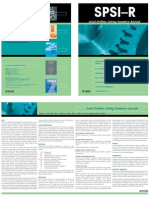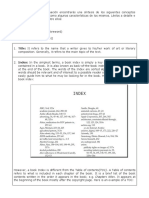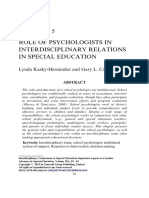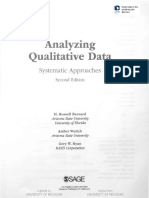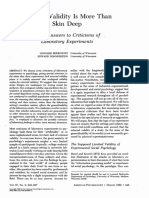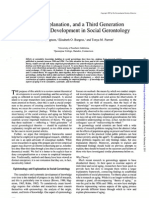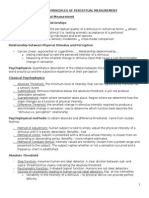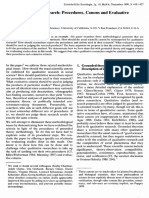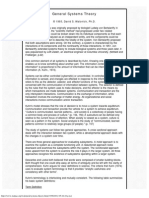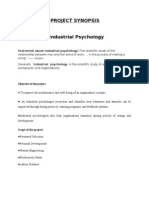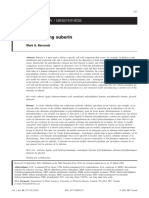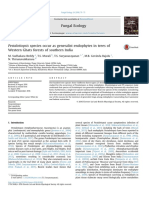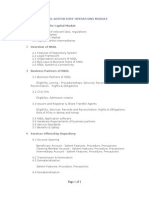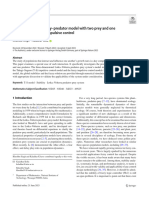Fleiss 1981
Fleiss 1981
Uploaded by
Diana BecerraCopyright:
Available Formats
Fleiss 1981
Fleiss 1981
Uploaded by
Diana BecerraCopyright
Available Formats
Share this document
Did you find this document useful?
Is this content inappropriate?
Copyright:
Available Formats
Fleiss 1981
Fleiss 1981
Uploaded by
Diana BecerraCopyright:
Available Formats
Balanced Incomplete Block Designs
for Inter-Rater Reliability Studies
Joseph
L. Fleiss
Columbia University and New York State Psychiatric Institute
Occasionally, an inter-rater reliability study must
be designed so that each subject is rated by fewer
than all the participating raters. If there is interest
in comparing the raters mean levels of rating, and
if it is desired that each mean be estimated with the
same precision, then a balanced incomplete block
design for the reliability study is indicated.
Methods for executing the design and for analyzing
the resulting data are presented, using data from
an
actual
study
for illustration.
Inter-rater reliability studies are frequently conducted prior to the initiation of a research undertaking in order to ascertain how reliable the ratings to be obtained in the major study may be expected to be. Suppose that m raters are to be compared in a reliability study, but that fewer than m
are able to rate any given subject. For example, if the rating is to be made on the basis of a detailed
examination or interview of the subject, then there may be a limit to the number of times the subject
can be repeatedly examined. If one rater conducts an interview in the presence of the other raters, and
they all make their observations and ratings at the same time, then the difficulty and expense in having all raters present at each interview places a great burden on the investigator.
Suppose that k (< m) is the number of raters who can feasibly rate any single subject. If there is
little or no interest in comparing the mean levels of rating for the several raters, then a simple random
sample of k out of the m raters may be selected, separately and independently for each subject.
Shrout and Fleiss (1979) have discussed the occasional appropriateness of this kind of study (a oneway random effects design, in the terminology of the analysis of variance).
If, however, there is interest in the mean levels of rating for the m raters, and if it is required that
each raters mean be estimated with the same precision, then a degree of structure must be imposed
on the assignment of raters to subjects. The balanced incomplete block design (originally proposed by
Yates, 1936) is presented in this paper as an appropriate study method for the problem at hand.
Methods for estimating and comparing the mean levels of rating are then discussed, followed by
methods for estimating and making inferences about the intraclass correlation coefficient of relia-
bility.
APPLIED PSYCHOLOGICAL MEASUREMENT
Vol. 5. No. 1. Winter 1981, pp. 105-112
@ Copyright 1981 Applied Psychological Measurement Inc.
105
Downloaded from apm.sagepub.com at UNIV WASHINGTON LIBRARIES on January 9, 2015
106
The Balanced Incomplete Block Design
Consider the reliability study design laid out in Table 1, where each entry is the rating given by
the indicated rater to the indicated subject. Note the following features of the design.
1. Each of the 10 subjects is rated by three raters;
2. Each of the six raters rates five subjects; and
3. Each pair of raters jointly rate two subjects.
These features characterize the study as a balanced incomplete block design (BIBD).
Let, in general, m denote the total number of raters involved in the study, n the total number of
subjects being rated, k the number of raters rating any subject (k<m), r the number of subjects rated
by any rater (r<n), and A the number of subjects rated by any pair of raters. Necessary conditions for
the existence of a BIBD with these parameters are
Note that the above design satisfies these conditions, with m=6, n=10, k=3, r=5, and ~l=2. Listings of
BIBDs for a wide variety of parameter values are given in Cochran and Cox (1957, pp. 469-482).
The actual reliability study associated with a BIBD can be executed in a variety of ways, provided
that randomization is applied at some stage. Perhaps the simplest method is to order the n groupings
of raters in some arbitrary fashion. Whenever a subject becomes available for study, one grouping of
raters is selected at random to jointly rate that subject, and the selected grouping is not used again.
Analysis of Rater Effects
Let X,, denote the rating given by the ih rater to the j subject. The following linear model is assumed to apply to X,:
Table 1.
Results of a Reliability Study of a Rating Scale
for Depression Designed as a BIBD
Downloaded from apm.sagepub.com at UNIV WASHINGTON LIBRARIES on January 9, 2015
107
In
Equation 4, ~ is the mean level of rating in the population of subjects, averaged over all raters; a, is
the effect due to the i&dquo; rater, with
s; is the effect due to the jh subject, with the s;s assumed to be independently and normally distributed with mean 0 and variance o,2; and eij is the residual random error of measurement. The e,,s
are assumed to be mutually independent, independent of the s;s, and normally distributed with mean
0 and variance e,. Finally, the assumption is made of no rater-by-subject interaction.
Define X, to be the mean of the r ratings given by rater i, and Xj to be the mean of the k ratings
on subject j. Define M, to be the mean of the X,s for those r subjects rated by rater i; in Table 1, for
the so-called efficiency factor of the given design. The quantity l-E is the maximum proportionate
reduction in efficiency (i.e., precision) for the given design relative to a randomized block design with
each of m raters rating each of r subjects. If the setting in which the ratings are made is such that
chance measurement errors increase as the number of raters per subject increases, the loss in efficiency will be less than I-E.
The statistic
is the least squares estimate of a;, the effect due to the il rater, and X..+ ai is the least squares estimate of the ih raters mean, where X.. is the grand mean of all the ratings.
The estimation of the rater means for the data of Table 1 is shown in Table 2. Note that the value
12/15
.80. The loss in efficiency relative to a ranof the efficiency factor E is (5x2+2)/(5x3)
domized block design with six raters and five subjects is no greater than 20%. The least squares
estimates of the rater means are a great deal closer one to another than a comparison of the simple
=
mean values, the Xi.s, would suggest. The latter are more variable than the least squares estimates
because they fail to take account of the particular subjects assigned, at random, to the m raters.
Table 3 presents the algebra of the analysis of variance for analyzing the raters effects. The sum
of squares for subjects ignoring raters is the usual sum of squares that would be calculated for measuring variability among the subjects means. It measures differences among the rater effects as well
Table 2
Estimation of Rater Means for Data of
Table 1
Downloaded from apm.sagepub.com at UNIV WASHINGTON LIBRARIES on January 9, 2015
108
-P
o
(1)
4-~
CH
W
~
(U
cd
m
4D
!=!
.r-q
N
~r-i
Cd
z
on
(1) 0
8 CH
CL~ Q)
H 8
IE-i
0
u
-H9
~-4
CLI
CH
0
.r-i
N
~
r-i
Cd
n
Downloaded from apm.sagepub.com at UNIV WASHINGTON LIBRARIES on January 9, 2015
109
subject-to-subject variability, however, as seen in the column of expected mean squares. It is calonly to permit the easy determination of the correct error sum of squares by subtraction.
When divided by its degrees of freedom, the resulting mean square for error, MSE, is an unbiased estimate of oe. In the formula for the total sum of squares, 7-7-Xl denotes the sum of the squares of the
nk ratings actually made.
The hypothesis that all m rater means are equal (equivalently, that a,=...=am=0) may be tested by
referring the value of
as
culated
to tables of the F
distribution with m-1 and ~r-~!-M+l degrees of freedom, and rejecting the hypothesis if the calculated F ratio is significantly large. If the hypothesis is rejected, the Scheff6 (1959)
method of multiple comparisons may be used to test which raters have significantly different mean
levels of rating from which others. If the efficiency factor E is low (less than ~3, say), comparisons
among raters may be much less powerful than in the corresponding randomized block design.
Let Ci, C2,,,,,Cm be any set of constants, at least two of which are unequal, that sum to zero. The
contrast
is judged to differ significantly from zero if and only if
the tabulated critical F value with m-1 and wr-~!-M+l degrees of freedom. When one of the raters
(say the first) appears to have an effect different from that of the others, the constants will be c i = +1I
and C2 =...= c_ = -1/(m-1). When one set of raters (say the firstp) seem to have effects different from
that of the others, the constants will be Cl =... = cp = I lp, and Cp+1 =...=c&dquo;, _ -1/(m p).
Table 3 also presents the analysis of variance table for analyzing the rater effects for the data in
Table 1. The value of FR is less than unity, indicating the absence of significant variation among the
rater
means.
Analysis of Subject Effects
The analysis outlined in Table 4 must be undertaken in order to make inferences about the relative magnitude of the two components of variance, o2 and o~, and in particular about the intraclass
correlation coefficient of reliability (Shrout & Fleiss, 1979),
The
sum
analysis begins with the calculation of the sum of squares for raters ignoring subjects, the usual
of squares for measuring variability among the raters means. It measures subject-to-subject
variability as well as differences among the rater effects, however. With the total sum of squares calculated in the usual way, and with the residual sum of squares given in Table 3, the correct sum of
squares for subjects, with rater effects eliminated, is obtained by subtraction.
An estimate of the intraclass correlation coefficient is
Downloaded from apm.sagepub.com at UNIV WASHINGTON LIBRARIES on January 9, 2015
110
M
+3
U
a)
4-i
If.-
H
4-~
o
U)
M
0
N
oJCd
~-4
a) 0
H If.-
Cd
a)
80J
~
8
0)
o
9
~-4
Cd
q-4
0
m
.,-i
M
r--i
Cd
Downloaded from apm.sagepub.com at UNIV WASHINGTON LIBRARIES on January 9, 2015
111
where
Unlike the case for a completely balanced design, the distribution of Fs is not exactly that of a constant times a central F variate (Wald, 1941), but it may be so approximated quite well. Let Fa denote
the tabulated critical F value with n-1 and mr-m-n+1 degrees of freedom. An approximate onesided 100(1-a)% confidence interval for the population intraclass correlation (see Feldt, 1965) is
The value of F, is 92.35/9.23 = 10.01, and an estimate of the intraclass correlation coefficient is
indicating good reliability. From tables of the F distribution, the critical .05 value for F with 9 and 15
degrees of freedom is found to be F,, 2.59. An approximate one-sided 95% confidence interval for
the population coefficient is therefore
=
Discussion
The efficiency factor E defined in Equation 6 appears several times in the analysis. If the design
completely balanced as in a randomized block design, with each rater rating each subject, the
value of E would be unity. For a BIBD, the value of E is always less than unity. Values of E less than
.67 or so usually mean such a great loss of efficiency that an alternative BIBD, with more raters rating
each subject, should be considered.
Probably the most serious drawback to a BIBD for an inter-rater reliability study is the possibility
that one or more raters may fail to make ratings as scheduled. The analysis becomes exceedingly complicated when data are missing (Cochran & Cox, 1957, pp. 450-452). If the investigator deems the
likelihood high that vagaries of schedules or other factors will produce missing ratings, he or she
should not plan a BIBD, should let chance determine which raters rate which subjects, and should
not expect to learn much about systematic differences among the raters means. The intraclass correlation coefficient of reliability would still be estimable, however (Shrout & Fleiss, 1979).
were
References
Cochran, W. G., & Cox, G. M. Experimental designs
(2nd ed.). New York: Wiley, 1957.
Feldt, L. S. The approximate sampling distribution
of Kuder-Richardson reliability coefficient twenty.
, 357-370.
30
, 1965,
Psychometrika
Scheffé, H. The analysis of variance. New York:
Wiley, 1959.
Shrout, P. E., & Fleiss, J. L. Intraclass correlations:
Uses in
assessing
rater
reliability. Psychological
Bulletin, 1979,
, 420-428.
86
Downloaded from apm.sagepub.com at UNIV WASHINGTON LIBRARIES on January 9, 2015
112
Wald, A. On the analysis of variance in case of multiclassifications with unequal class frequencies.
Annals of Mathematical Statistics
, 1941, 12
,
346-350.
Yates, F. Incomplete randomised blocks. Annals of
, 121-140.
7
Eugenics, 1936,
Authors Address
ple
Joseph L. Fleiss, Division of Biostatistics,
University School of Public Health, 600
Street, New York, NY 10032.
Acknowledgments
This work was supported in part by grant MH
28655 from the National Institute of Mental Health.
Downloaded from apm.sagepub.com at UNIV WASHINGTON LIBRARIES on January 9, 2015
Columbia
West 168
You might also like
- Click Here For Download: (PDF) Single-Case Designs For Educational ResearchDocument4 pagesClick Here For Download: (PDF) Single-Case Designs For Educational ResearchMURALIPRAKASH.S 18BIT1310% (2)
- Bovens, Luc, The Value of Hope, 1999Document16 pagesBovens, Luc, The Value of Hope, 1999Laura QuintanaNo ratings yet
- Paul Newham - Using Voice and Song in TherapyDocument152 pagesPaul Newham - Using Voice and Song in TherapyLaimis Motuza75% (4)
- Chapter Vii WritingDocument26 pagesChapter Vii WritingGabriel HernandezNo ratings yet
- (Scientific Psychology Series) William R. Uttal-The War Between Mentalism and Behaviorism - On The Accessibility of Mental Processes-Lawrence Erlbaum Associates (2000) PDFDocument250 pages(Scientific Psychology Series) William R. Uttal-The War Between Mentalism and Behaviorism - On The Accessibility of Mental Processes-Lawrence Erlbaum Associates (2000) PDFmonomaniahomicidaNo ratings yet
- Conducta Social Staats PDFDocument39 pagesConducta Social Staats PDFMarco GonzalesNo ratings yet
- Northwest Instrument Total Station NTS02 ManualDocument62 pagesNorthwest Instrument Total Station NTS02 ManualLuis Martínez100% (1)
- SPSI R BrochureDocument2 pagesSPSI R BrochureNoreen Choudhri0% (1)
- Titulo, Indice, Prefacio, Autor, ApendicesDocument2 pagesTitulo, Indice, Prefacio, Autor, ApendicesTess TaylerNo ratings yet
- Actividad 2 - Kasky-Hernandez & Cates (2015)Document14 pagesActividad 2 - Kasky-Hernandez & Cates (2015)Pedraza A. Mario100% (1)
- Bernard - Analyzing Qualitative Data - CAP5Document25 pagesBernard - Analyzing Qualitative Data - CAP5Jhonny B MezaNo ratings yet
- Easy Lover BassTabDocument2 pagesEasy Lover BassTabRoger0% (1)
- Berkowitz, Donnerstein - 1982 - External Validity Is More Than Skin Deep Some Answers To Criticisms of Laboratory Experiments PDFDocument13 pagesBerkowitz, Donnerstein - 1982 - External Validity Is More Than Skin Deep Some Answers To Criticisms of Laboratory Experiments PDFLindsey TanNo ratings yet
- Q-METHOD Watts & Stenner Chapter 1Document21 pagesQ-METHOD Watts & Stenner Chapter 1mangomousseNo ratings yet
- Perception of Organisational Climate in Nursing StaffDocument12 pagesPerception of Organisational Climate in Nursing Stafflucky prajapatiNo ratings yet
- Intrinsic Motivation Inventory (Motivatie Intrinseca)Document12 pagesIntrinsic Motivation Inventory (Motivatie Intrinseca)amaandreiNo ratings yet
- Spirituality and The MMPI-2 PDFDocument12 pagesSpirituality and The MMPI-2 PDFIqra LatifNo ratings yet
- Assessing Special StudentsDocument21 pagesAssessing Special StudentsKhalid SaeedNo ratings yet
- Dimensions of Psychological TheoryDocument8 pagesDimensions of Psychological TheoryJosé Carlos Sánchez-RamirezNo ratings yet
- Exploratory ResearchDocument1 pageExploratory ResearchSanthosh T KarthickNo ratings yet
- Digit Span ActivityDocument3 pagesDigit Span ActivityPrisha JainNo ratings yet
- Theory, Explanation, and A Third Generationof Theoretical Development in Social GerontologyDocument17 pagesTheory, Explanation, and A Third Generationof Theoretical Development in Social GerontologyOlga Verbochka0% (1)
- Ways of Coping Questionnaire WCQ ToadDocument15 pagesWays of Coping Questionnaire WCQ ToadIeva BagataNo ratings yet
- Pink Floyd All The Songs-297-525Document229 pagesPink Floyd All The Songs-297-525SalsamendiNo ratings yet
- Chapter 1 NotesDocument4 pagesChapter 1 Notesjchyeung20No ratings yet
- STS CRFDocument38 pagesSTS CRFYosoy LomasNo ratings yet
- Sroufe&Rutter1984. The Domain of Development PsychopathologyDocument15 pagesSroufe&Rutter1984. The Domain of Development PsychopathologyAndrés EstradéNo ratings yet
- Metaanalysis of Heart Rate Variability As A Psychophysiological Indicator of Posttraumatic Stress Disorder 2167 1222.1000182Document8 pagesMetaanalysis of Heart Rate Variability As A Psychophysiological Indicator of Posttraumatic Stress Disorder 2167 1222.1000182DmitriyNo ratings yet
- BullyingDocument8 pagesBullyingclaudia patricia jimenez jaramilloNo ratings yet
- Reactions OF Strips OF Rabbit Aorta TO Epinephrixe, Isopropylarterenol, Sodium Nitrite AND Other Drugs'Document15 pagesReactions OF Strips OF Rabbit Aorta TO Epinephrixe, Isopropylarterenol, Sodium Nitrite AND Other Drugs'Cata León100% (1)
- Protocol For Heart Rate Variability Biofeedback TrainingDocument13 pagesProtocol For Heart Rate Variability Biofeedback TrainingLevente BalázsNo ratings yet
- Kantor 1974 Interbehavioral Psychology How Related To The Experimental Analysis of BehaviorDocument6 pagesKantor 1974 Interbehavioral Psychology How Related To The Experimental Analysis of BehaviorVíctor Eduardo FuentesNo ratings yet
- The Dark Triad at Work How Toxic Employees GetDocument6 pagesThe Dark Triad at Work How Toxic Employees GetMAKTAR5422No ratings yet
- Fraenkel and WallenDocument8 pagesFraenkel and WallenStephanie UmaliNo ratings yet
- Organizational Commitment, Job Satisfaction and Turnover Among Psychiatric Technicians - Mowday, Porter e SteersDocument25 pagesOrganizational Commitment, Job Satisfaction and Turnover Among Psychiatric Technicians - Mowday, Porter e SteersLeonardo BarretoNo ratings yet
- MIPS Inventario Millon de Estilos de Personalidad: Institución AñoDocument18 pagesMIPS Inventario Millon de Estilos de Personalidad: Institución AñoDAYANANo ratings yet
- Corbin & Strauss - 1990 - Grounded Theory ResearchDocument10 pagesCorbin & Strauss - 1990 - Grounded Theory ResearchFeñav DoorNo ratings yet
- HP CSS Possible Research ToolDocument2 pagesHP CSS Possible Research ToolPollen Siega BunalNo ratings yet
- Burnout Salud MentalDocument16 pagesBurnout Salud MentalRodrigo VillalbaNo ratings yet
- Lecture NotesDocument41 pagesLecture NotesAkeem Emmanuel Uy Feria100% (1)
- Resiliencia. La Ciencia de Dominar Los Mayores Desafíos de La VidaDocument283 pagesResiliencia. La Ciencia de Dominar Los Mayores Desafíos de La VidaHenry RuedaNo ratings yet
- General Systems TheoryDocument11 pagesGeneral Systems TheoryAmada EspinoNo ratings yet
- 2 Plantilla Calificacion HMP PDFDocument1 page2 Plantilla Calificacion HMP PDFAnonymous 1kMpLnpdmNo ratings yet
- Parent Modernity ScaleDocument5 pagesParent Modernity ScaleMaya MayaNo ratings yet
- Synopsis On Industrial PsychologyDocument3 pagesSynopsis On Industrial PsychologyKeya FariaNo ratings yet
- Psychological First Aid - Lecture 1: Terms and ConceptsDocument14 pagesPsychological First Aid - Lecture 1: Terms and ConceptsDebbie Wong0% (1)
- Problem Solving - Decision Making (Ages 13 - 20) - 1Document5 pagesProblem Solving - Decision Making (Ages 13 - 20) - 1sara sibyNo ratings yet
- Declaración PRISMADocument11 pagesDeclaración PRISMAYanitzia Natalia Verjan AvilaNo ratings yet
- Whoqol BrefDocument7 pagesWhoqol BrefreetikaNo ratings yet
- Guia-G1 Resiliencia PDFDocument14 pagesGuia-G1 Resiliencia PDFZamara AcostaNo ratings yet
- El Analisis Dialogico Del Discurso ADD y PDFDocument19 pagesEl Analisis Dialogico Del Discurso ADD y PDFMARTHA LIBIA PALMERA GUERRANo ratings yet
- Rev Proactive Coping Green Glass EdiriDocument51 pagesRev Proactive Coping Green Glass Ediriravibunga4489No ratings yet
- Los Estilos de Aprendizaje Procedimientos de Diagnostico y MejoraDocument223 pagesLos Estilos de Aprendizaje Procedimientos de Diagnostico y Mejoramarinett santeNo ratings yet
- Test WarteggDocument26 pagesTest WarteggCate AcostaNo ratings yet
- Interactions Between Rodent Visual and Spatial Systems During NavigationDocument15 pagesInteractions Between Rodent Visual and Spatial Systems During Navigation伟健宗No ratings yet
- The Landscape of Qualitative Research IntroductionDocument20 pagesThe Landscape of Qualitative Research Introductionebavf28No ratings yet
- Neo-Five-Factor Inventory (NEO-FFI)Document22 pagesNeo-Five-Factor Inventory (NEO-FFI)rajpurkarpraj31No ratings yet
- Antecedente 4Document13 pagesAntecedente 4greissyNo ratings yet
- Messick, 1980Document16 pagesMessick, 1980PaolaNo ratings yet
- Cacioppo Handbook of Psicophisio PDFDocument26 pagesCacioppo Handbook of Psicophisio PDFAuelillaNo ratings yet
- Factor AnalysisdDocument20 pagesFactor Analysisdsubhas9804009247No ratings yet
- Chapter Two - Estimators.2Document8 pagesChapter Two - Estimators.2bshankar481No ratings yet
- Demystifying Suberin: Minireview / MinisynthèseDocument14 pagesDemystifying Suberin: Minireview / MinisynthèseDiana BecerraNo ratings yet
- Reddy2016 Fungal EcologyDocument6 pagesReddy2016 Fungal EcologyDiana BecerraNo ratings yet
- Fungi EcologyDocument4 pagesFungi EcologyDiana BecerraNo ratings yet
- The Recovery Inter-Block Information I N Balanced Incomplete Block DesignsDocument9 pagesThe Recovery Inter-Block Information I N Balanced Incomplete Block DesignsDiana BecerraNo ratings yet
- Muji Case Study PDFDocument38 pagesMuji Case Study PDFjorjojorNo ratings yet
- Unit 6 Information Communication Technology (Ict)Document27 pagesUnit 6 Information Communication Technology (Ict)Christine Joy MarananNo ratings yet
- C1000-154 STU C1000154v2STUSGC1000154Document10 pagesC1000-154 STU C1000154v2STUSGC1000154Gisele SouzaNo ratings yet
- Family Feud - Template by SlideLizard - enDocument24 pagesFamily Feud - Template by SlideLizard - enmariadivinabacani0427No ratings yet
- Class-X Physics Home Work-1B (Theory) : Chapter: Physical Quantity, Kinematics, DynamicsDocument18 pagesClass-X Physics Home Work-1B (Theory) : Chapter: Physical Quantity, Kinematics, DynamicsNuha TasniahNo ratings yet
- HSE Requirements-Rev01 - Site RequirmentDocument1 pageHSE Requirements-Rev01 - Site RequirmentBRC HSE Dept.No ratings yet
- Đề Cương KTCK2 - GS11 - 2023-2024Document8 pagesĐề Cương KTCK2 - GS11 - 2023-2024Dũng HuỳnhNo ratings yet
- Qlik ViewDocument247 pagesQlik Viewsunnytspice0% (1)
- Building Advanced Grafana DashboardsDocument36 pagesBuilding Advanced Grafana DashboardssrinivasNo ratings yet
- Open Call The Consulting Room of The Future - Erasmus MCDocument5 pagesOpen Call The Consulting Room of The Future - Erasmus MCnikitaaroranidNo ratings yet
- Wireframe 62Document116 pagesWireframe 62feriferiNo ratings yet
- PMSBY Cons-Cum-Decl Orm - 10062021Document2 pagesPMSBY Cons-Cum-Decl Orm - 10062021subrahmanyamNo ratings yet
- The Four Processes in The Rankine CycleDocument3 pagesThe Four Processes in The Rankine CyclesahiiiiNo ratings yet
- SocialMiner Release 8Document17 pagesSocialMiner Release 8eduardo perezNo ratings yet
- Technical Preboard Exam 2Document6 pagesTechnical Preboard Exam 2Allan BitonNo ratings yet
- Curriculum - Nsdl-Depository Operations Module: Overview of The Capital MarketDocument3 pagesCurriculum - Nsdl-Depository Operations Module: Overview of The Capital MarketSubrat TripathiNo ratings yet
- Quizquizhotahaiwithanswers 110922140244 Phpapp01Document90 pagesQuizquizhotahaiwithanswers 110922140244 Phpapp01Sushmita SahuNo ratings yet
- PPG 0580-9000 Thinners - SDS - 058090005Document16 pagesPPG 0580-9000 Thinners - SDS - 058090005crushergaming1804No ratings yet
- Stability Analysis of Prey-Predator Model With Two Prey and One Predator Using Fuzzy Impulsive ControlDocument14 pagesStability Analysis of Prey-Predator Model With Two Prey and One Predator Using Fuzzy Impulsive Controlkkr.nitpyNo ratings yet
- Why Don't You Say What You MeanDocument4 pagesWhy Don't You Say What You MeanC Jay100% (2)
- Biocompatibility of Poly (Acrylonitrile-Butadiene-styrene) Nanocomposites Modified With Silver NanoparticlesDocument13 pagesBiocompatibility of Poly (Acrylonitrile-Butadiene-styrene) Nanocomposites Modified With Silver NanoparticlesMaqsoodUlHassanChaudharyNo ratings yet
- Automotive Interview Questions 1707472977Document2 pagesAutomotive Interview Questions 1707472977emsm06No ratings yet
- SchoolDocument11 pagesSchooltaseenalam04No ratings yet
- World Orca Mini 25Document26 pagesWorld Orca Mini 25Ricardo Díaz GarduñoNo ratings yet
- Business Report SAMPLEDocument3 pagesBusiness Report SAMPLEaislinn.hoqueNo ratings yet
- Debate C1Document2 pagesDebate C1litlemouzNo ratings yet
- Connecting Your Goals To LPC AssignmentDocument6 pagesConnecting Your Goals To LPC AssignmentJamison FawkesNo ratings yet
- Titanium Grades PDFDocument7 pagesTitanium Grades PDFMatt AgonyaNo ratings yet







